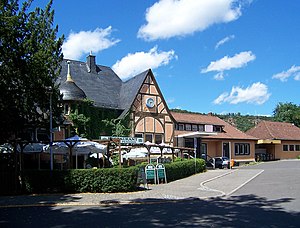Bad Münster am Stein station
| Through station | |||||||||||||||||||||||||||||||

Entrance building (street side)
|
|||||||||||||||||||||||||||||||
| Location | Berliner Str. 20, Bad Münster am Stein-Ebernburg, Bad Kreuznach, Rhineland-Palatinate Germany |
||||||||||||||||||||||||||||||
| Coordinates | 49°48′48″N 7°50′49″E / 49.813398°N 7.8470063°ECoordinates: 49°48′48″N 7°50′49″E / 49.813398°N 7.8470063°E | ||||||||||||||||||||||||||||||
| Line(s) |
|
||||||||||||||||||||||||||||||
| Platforms | 4 | ||||||||||||||||||||||||||||||
| Construction | |||||||||||||||||||||||||||||||
| Architectural style | Jugendstil | ||||||||||||||||||||||||||||||
| Other information | |||||||||||||||||||||||||||||||
| Station code | 307 | ||||||||||||||||||||||||||||||
| DS100 code | SBMS | ||||||||||||||||||||||||||||||
| IBNR | 8000726 | ||||||||||||||||||||||||||||||
| Category | 4 | ||||||||||||||||||||||||||||||
| Website | www.bahnhof.de | ||||||||||||||||||||||||||||||
| History | |||||||||||||||||||||||||||||||
| Opened | 15 December 1859 | ||||||||||||||||||||||||||||||
| Services | |||||||||||||||||||||||||||||||
|
|||||||||||||||||||||||||||||||
Bad Münster am Stein station is a station at a railway junction in Bad Münster am Stein-Ebernburg, a district of Bad Kreuznach in the German state of Rhineland-Palatinate. The station building, dating from about 1910, is protected as a monument. It is classified by Deutsche Bahn as a category 4 station. The station is located in the network of the Rhein-Nahe-Nahverkehrsverbund (Rhine-Nahe local transport association, RNN) and belongs to fare zone 401. Its address is: Berliner Straße 20.
The station, opened in 1859, was initially a through station on the Nahe Valley Railway (Nahetalbahn), which was built by the Rhine-Nahe Railway Company (Rhein-Nahe-Bahn). In 1871, the Alsenz Valley Railway (Alsenztalbahn) was opened from Hochspeyer with its northern terminus in the town then called just Münster. From 1904 to 1961, it was also the north-eastern terminus of the Glan Valley Railway (Glantalbahn), a strategic railway running to Homburg.
The station is located in the centre of the district of Bad Münster am Stein. It has a telephone, parking and a taxi rank.
The Nahe Valley Railway comes from the north-east and shortly before reaching the station, it crosses the Nahe river on a bridge. It then turns to the west to run on the left (western) bank of the Nahe. The Alsenz Valley Railway comes from the south-southwest and also bridges the Nahe, a few hundred metres down river from the Nahe Valley Railway. The now closed Glan Valley Railway ran on the right bank of the Nahe, before crossing the river shortly before the Alsenz Valley Railway and connecting with the Nahe Valley Railway.
Although initial efforts to create a railway along the Nahe go back to 1839, disputes between Prussia and the Grand Duchy of Oldenburg over the route, however, delayed its realisation. While Prussia preferred the line run directly along the Nahe, Oldenburg promoted a line through Birkenfeld, which is in a side valley, which was also the capital of its exclave, the Birkenfeld Principality (Fürstentum Birkenfeld). In 1856, the then Bavarian Palatinate proposed that the planned railway leave the Nahe Valley at Boos and run to Altenglan along the Glan via Kusel and from there to St. Wendel or alternatively along the Oster valley to Neunkirchen. The basis of this third variant was the fact that it would be shorter and cheaper than a line along the length of the Nahe. For tactical reasons, Prussia initially expressed interest in these plans, which led to Oldenburg giving way and accepting the route along the Nahe within its territory.
...
Wikipedia
